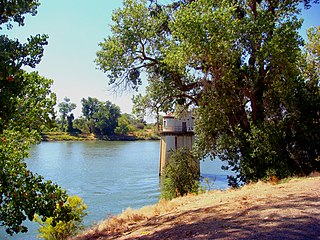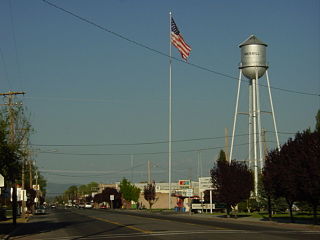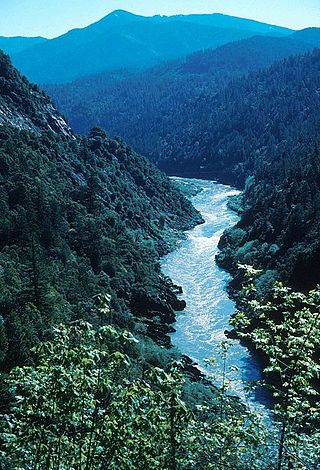Related Research Articles

The Sacramento River is the principal river of Northern California in the United States and is the largest river in California. Rising in the Klamath Mountains, the river flows south for 400 miles (640 km) before reaching the Sacramento–San Joaquin River Delta and San Francisco Bay. The river drains about 26,500 square miles (69,000 km2) in 19 California counties, mostly within the fertile agricultural region bounded by the Coast Ranges and Sierra Nevada known as the Sacramento Valley, but also extending as far as the volcanic plateaus of Northeastern California. Historically, its watershed has reached as far north as south-central Oregon where the now, primarily, endorheic (closed) Goose Lake rarely experiences southerly outflow into the Pit River, the most northerly tributary of the Sacramento.

Siskiyou County is a county located in the northwestern part of the U.S. state of California. As of the 2020 census, the population was 44,076. Its county seat is Yreka and its highest point is Mount Shasta. It falls within the Cascadia bioregion.

Klamath Falls is a city in, and the county seat of, Klamath County, Oregon, United States. The city was originally called Linkville when George Nurse founded the town in 1867. It was named after the Link River, on whose falls the city was sited. The name was changed to Klamath Falls in 1893. The population was 21,813 at the 2020 census. The city is on the southeastern shore of the Upper Klamath Lake. It is located 80 miles (130 km) east of Medford, 250 miles (400 km) northwest of Reno, and approximately 10 miles (16 km) north of the California–Oregon border.

Merrill is a city in Klamath County, Oregon, United States. The population was 844 at the 2010 census.

The Modoc are an Indigenous American people who historically lived in the area which is now northeastern California and central Southern Oregon. Currently, they include two federally recognized tribes, the Klamath Tribes in Oregon and the Modoc Tribe of Oklahoma, now known as the Modoc Nation.

The Klamath River flows 257 miles (414 km) through Oregon and northern California in the United States, emptying into the Pacific Ocean. By average discharge, the Klamath is the second largest river in California after the Sacramento River. It drains an extensive watershed of almost 16,000 square miles (41,000 km2) that stretches from the arid country of south-central Oregon to the temperate rainforest of the Pacific coast. Unlike most rivers, the Klamath begins in the high desert and flows toward the mountains – carving its way through the rugged Cascade Range and Klamath Mountains before reaching the sea. The upper basin, today used for farming and ranching, once contained vast freshwater marshes that provided habitat for abundant wildlife, including millions of migratory birds. Most of the lower basin remains wild, with much of it designated wilderness. The watershed is known for this peculiar geography, and the Klamath has been called "a river upside down" by National Geographic magazine.

The Rogue River in southwestern Oregon in the United States flows about 215 miles (346 km) in a generally westward direction from the Cascade Range to the Pacific Ocean. Known for its salmon runs, whitewater rafting, and rugged scenery, it was one of the original eight rivers named in the Wild and Scenic Rivers Act of 1968. Beginning near Crater Lake, which occupies the caldera left by the explosive volcanic eruption and collapse of Mount Mazama, the river flows through the geologically young High Cascades and the older Western Cascades, another volcanic province. Further west, the river passes through multiple exotic terranes of the more ancient Klamath Mountains. In the Kalmiopsis Wilderness section of the Rogue basin are some of the world's best examples of rocks that form the Earth's mantle. Near the mouth of the river, the only dinosaur fragments ever discovered in Oregon were found in the Otter Point Formation, along the coast of Curry County.

The Chinook salmon is the largest and most valuable species of Pacific salmon. Its common name is derived from the Chinookan peoples. Other vernacular names for the species include king salmon, Quinnat salmon, Tsumen, spring salmon, chrome hog, Blackmouth, and Tyee salmon. The scientific species name is based on the Russian common name chavycha (чавыча).

The Klamath Project is a water-management project developed by the United States Bureau of Reclamation to supply farmers with irrigation water and farmland in the Klamath Basin. The project also supplies water to the Tule Lake National Wildlife Refuge, and the Lower Klamath National Wildlife Refuge. The project was one of the first to be developed by the Reclamation Service, which later became the Bureau of Reclamation.

Jason Atkinson is an American politician in the US state of Oregon. The Republican grew up in the Southern Oregon city of Ashland. He served as a senator in the Oregon State Senate from 2001 to 2013. He ran unsuccessfully for the Republican nomination for Governor of Oregon in 2006. He stated his intention to run in the 2010 Oregon gubernatorial election, but withdrew from the race in 2009.

The Yurok are an Indigenous people from along the Klamath River and Pacific coast, whose homelands are located in present-day California stretching from Trinidad in the south to Crescent City in the north.
The Klamath Tribes, formerly the Klamath Indian Tribe of Oregon, are a federally recognized Native American Nation consisting of three Native American tribes who traditionally inhabited Southern Oregon and Northern California in the United States: the Klamath, Modoc, and Yahooskin. The tribal government is based in Chiloquin, Oregon.

The Klamath Basin is the region in the U.S. states of Oregon and California drained by the Klamath River. It contains most of Klamath County and parts of Lake and Jackson counties in Oregon, and parts of Del Norte, Humboldt, Modoc, Siskiyou, and Trinity counties in California. The 15,751-square-mile (40,790 km2) drainage basin is 35% in Oregon and 65% in California. In Oregon, the watershed typically lies east of the Cascade Range, while California contains most of the river's segment that passes through the mountains. In the Oregon-far northern California segment of the river, the watershed is semi-desert at lower elevations and dry alpine in the upper elevations. In the western part of the basin, in California, however, the climate is more of temperate rainforest, and the Trinity River watershed consists of a more typical alpine climate.
Karuk traditional narratives include myths, legends, tales, and oral histories preserved by the Karuk (Karok) people of the Klamath River basin of northwestern California.
Modoc traditional narratives include myths, legends, tales, and oral histories preserved by the Modoc and Klamath people of northern California and southern Oregon.
Yurok traditional narratives include myths, legends, tales, and oral histories preserved by the Yurok people of the lower Klamath River in northwestern California.
Klamath and Salmon River War, or Klamath War, or Red Cap War, or Klamath River Massacres, was an American Indian War which occurred in Klamath County California from January to March 1855. The war began from incidents between local settlers and local Indians and a rumor of an Indian uprising against the miners along the Klamath River by the Yurok and Karok Native American tribes. Local miners wanted the Indians armed with guns and ammunition disarmed, anyone trading them to the Indians whipped and expelled from the County and any Indian found with firearms after that time was to be killed. Some of the Indians, mainly a group called the "Red Caps", refused to disarm, and hostilities began between them and the miners. Troops from the California State Militia and U. S. Army eventually stepped in.The conflict resulted in killings on both sides.
David Rains Wallace is an American writer who has published more than twenty books on conservation and natural history, including The Monkey's Bridge and The Klamath Knot. He has written articles for the National Geographic Society, The Nature Conservancy, the Sierra Club, and other groups. Wallace's work also has appeared in Harper's Magazine, The New York Times, Sierra, Wilderness and other periodicals.
The Klamath River is a river in southern Oregon and northern California in the United States. This article describes its course.
The 2002 Klamath River fish kill occurred on the Klamath River in California in September 2002. According to the official estimate of mortality, about 34,000 fish died. Though some counts may estimate over 70,000 adult chinook salmon were killed when returning to the river to spawn, making it the largest salmon kill in the history of the Western United States. Besides the chinook salmon, other fish that perished include: steelhead, coho salmon, sculpins, speckled dace, and Klamath smallscale sucker.
References
- ↑ Coll Thrush (January 2008). "River of Renewal: Myth and History in the Klamath Basin". Environmental History . Retrieved 2009-11-13.
- ↑ Freeman House (March–April 2007). "River of Renewal". Orion . Retrieved 2009-11-13.
- ↑ Jeff LaLande (Summer 2007). "River of Renewal: Myth and History in the Klamath Basin". Oregon Historical Quarterly . Archived from the original on 2008-11-21. Retrieved 2009-11-13.
- ↑ Stacy Trevenon (November 11, 2009). "Tune in to ride the 'River of Renewal'". Half Moon Bay Review . Retrieved 2009-11-13.